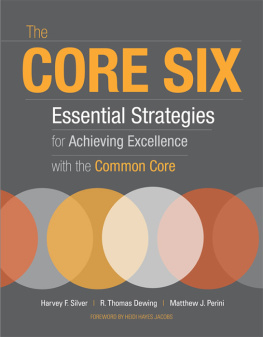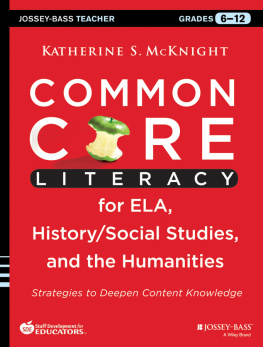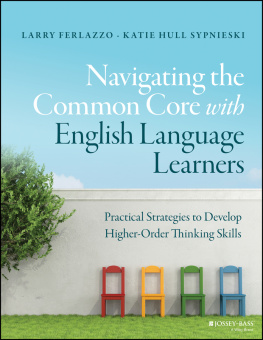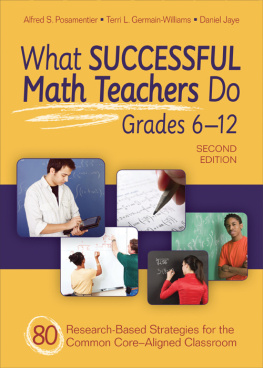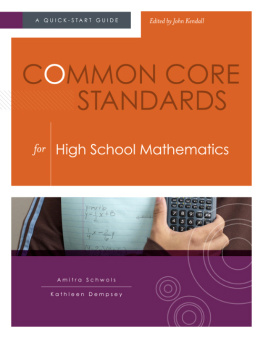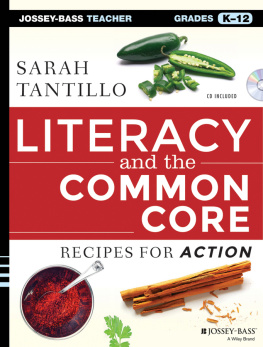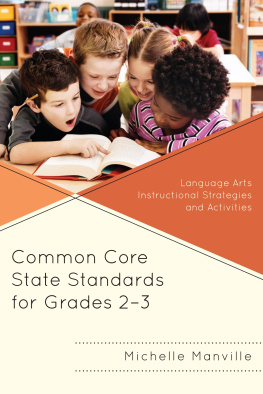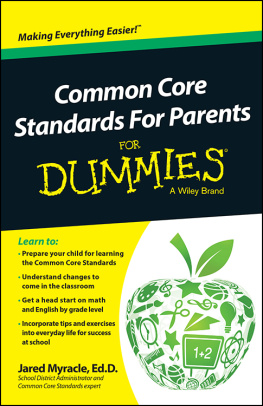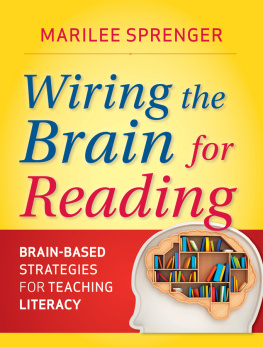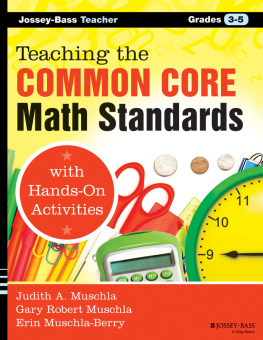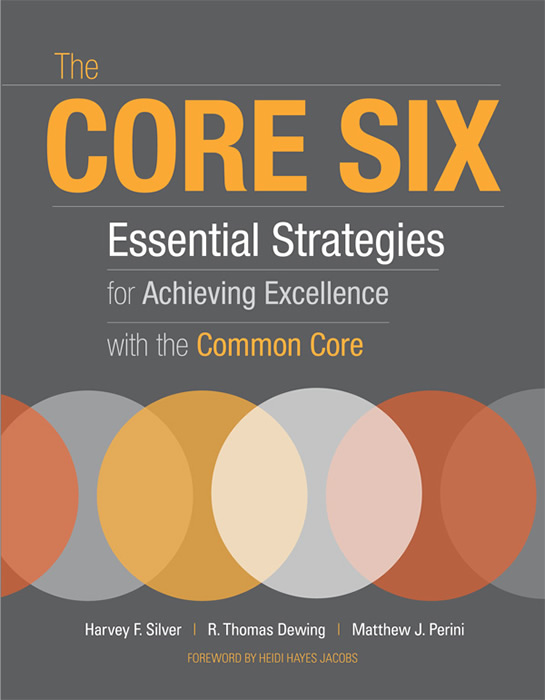Foreword
Heidi Hayes Jacobs
The word core has special meaning for educators. Core suggests what is essential, what is at the heart of teaching and learning. Whether designing curriculum units or laying out instructional plans, teachers make decisions about what to emphasize and what must sit by the wayside. How do we make cogent and meaningful choices about what is core for our learners? How can we have confidence in our instructional sequences so that our students forge a pathway to the core?
These questions take on even more significance with the advent of the Common Core State Standards, as schools and districts dive into unwrapping, scaffolding, and integrating these standards directly into their practice. While we seek guidance on how to address these new standards, we simultaneously wish to adhere to what we know worksthe finest of proven teaching methodology.
In your hands, you hold a genuine edu-toolkit loaded with clear, specific strategies to help you and your colleagues address key Common Corerelated challenges at all grade levels. Based on years of field experience and action research, Harvey Silver, Thomas Dewing, and Matthew Perini have shaped an eminently practical book focused on six core practices that students need to cultivate to become independent learners. The six strategies clearly address the CCSS, but they do more than that. Given that these Core Six impact lifelong learning, they directly support the mission of the architects of the Common Core to provide the basis for college and career readiness. The Core Six are
- Reading for Meaning.
- Compare & Contrast.
- Inductive Learning.
- Circle of Knowledge.
- Write to Learn.
- Vocabulary's CODE.
With these Core Six, the authors have taken the candid and refreshing point of view that you have already steeped yourself in the Common Core State Standards and are fully aware of the importance of this national initiative. Rather than providing a primer on the Common Core, the authors show how six essential strategies can provide a central focus for faculties, a common ground for schoolwide efforts to improve performance and increase student engagement.
Each core strategy is unpacked and revealed through examples for classroom practice with suggested phases, questions, and activities to assist any teacher in any subject. The book is loaded with charts, activity excerpts, images, and text features that make it easy for all teachers to implement the strategies. At the same time, creative teachers will be able to tweak and build on these numerous examples for adaptation in the classroom.
Most important, these Core Six are for our learners. The only person who can improve his or her performance is the individual student. We cannot do it for our students. Our task is to coach them, direct them, and support them so that they know how to assess and improve their own work. To do this well, students need strategies. I believe that these Core Six can easily be translated from teaching strategies to learning strategies for today's studentslearning strategies that can be directly fused with 21st century tools and contexts. With the Core Six under their belts, students will be better equipped to tackle the challenges of the future.
Silver, Dewing, and Perini have a spectacular track record of giving educators throughout the world approaches, strategies, and ways of thinking to reach learners and collaborate effectively. With The Core Six, the authors have generated another rich contribution to the field, helping us to make astute and critical choices about what should be core in our classrooms.
Acknowledgments
We gratefully acknowledge the contributions of Justin Gilbert. Justin did the hardest job of all: he got the three of us to move, and he brought coherence to our chaos. We would also like to thank the talented and thoughtful team at ASCD. Special thanks go to Genny Ostertag, David Hargis, and Miriam Goldstein.
Finally, we are thankful for Heidi Hayes Jacobs, who lent her distinctive voice and passion to this book's foreword within an almost impossible time frame. Heidi has a rare gift for connecting what's new in education to what's always been true about good teaching and learning.
Introducing the Core Six
Let's begin with what this book is not. This book is not a guide to the Common Core State Standards. In it, you will not find the story of how the Common Core emerged, a detailed description of what the standards cover, or an explanation of how the standards are organized. For this information, we recommend visiting the Common Core website (www.corestandards.org) or, for a deeper look, reading John Kendall's (2011) Understanding Common Core State Standards.
The Core Six is for educators who already have a strong grasp on the Common Core and are eager to do something about it. In this book, we offer a collection of research-based strategies that will help teachers and students respond to the demands of the Common Core, particularly the Common Core State Standards for English Language Arts & Literacy in History/Social Studies, Science, and Technical Subjects, which are a "shared responsibility within the school" (National Governors Association Center for Best Practices [NGA Center], Council of Chief State School Officers [CCSSO], 2010a, p. 4) and affect every subject area and grade level.
Regular use of the strategies in this book will help students become better at
- Reading and understanding rigorous texts.
- Evaluating evidence and using it to support positions.
- Conducting comparative analyses.
- Finding important patterns and structures built into content.
- Mastering academic vocabulary and integrating it into speech and writing.
- Understanding and contributing to meaningful discussions about content.
- Using writing to advance learning and clarify thinking.
- Writing comfortably in the key Common Core text types: arguments, informative/explanatory texts, and narratives.
Figure I.1 describes each of the six strategies offered in this book and highlights some of the Common Core skills that each strategy builds.
Making Research Work
Thanks to more than 40 years of research on classroom practice, we know better than ever what works. We know which strategies are likely to increase engagement and raise student achievement, and we know which are not worthy of instructional time. Every strategy in this book is backed by a strong research base.
But research is only part of the story. There is a real gap between research and practice, and any strategy can fall flat in the classroom. Take Compare & Contrast, a strategy that extensive research has found correlates with sizeable gains in student achievement. Ask a few hundred teachers about Compare & Contrast, however, and you will likely get a different take. We actually did ask a few hundred teachers about their experiences with Compare & Contrast and learned why a strategy with such a rich research base often fails and how to make classroom comparisons powerful and effective. Here's the gist: if you want to get results, you need to treat Compare & Contrast as a learning strategy rather than an end-of-learning assessment; make sure students have clear criteria for comparing items; and guide students to deeper thinking in phases.
When teachers make moves like these, student learning takes off. The promise of the research is realized. That's why, during the last 35 years, we have worked with thousands of teachers who have helped us test and refine strategies so that they are not only research-based but also classroom-proven. This holds true for every strategy in this book: all of them have been refined over time with the intent of making research come to life in the classroom.

